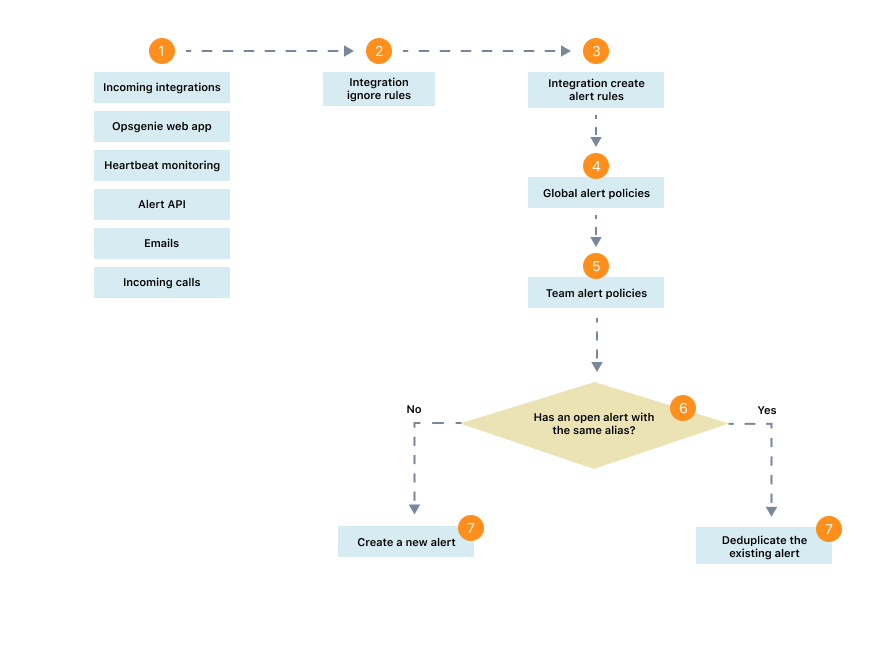アラート作成フロー
アラートの作成
アラート ソース
Opsgenie 内のアラートは、さまざまなソースを介して作成できます。
受信/双方向統合: Opsgenie が統合されている外部サービスまたはアプリケーションは、Opsgenie 内でアラートを作成できます。Opsgenie は、提供された API キーが属する統合の設定に従って外部サービスから受信したデータを処理し、必要に応じてアラートを作成します。[統合] セクションまたは [統合] ページを参照して、すでに統合している外部サービスのリストを参照してください。
メール: Opsgenie でメールを送信する機能を持つ任意のサービスまたはソフトウェアを統合します。メールの設定後、これらのメールを Opsgenie に転送します。Opsgenie はメール アドレスが属するメール統合の設定に従って、受信したメールを処理します。
アラートAPI: Opsgenie 内で API インテグレーションを設定した後に、アラート API の [Create Alert Requests (アラート リクエストの作成)] を使用してアラートを作成します。リクエスト内のすべてのデータは、提供された API キーが属する API インテグレーションの設定に従って処理されます。
Heartbeat 監視: Heartbeat 監視は Opsgenie 内でアラートを作成します。Opsgenie が定義した時間しきい値内に Heartbeat 送信リクエストを受信しなかった場合は、Heartbeat 統合の設定に従ってアラートが作成されます。
着信コール: 着信コール統合を設定する際に Opsgenie が提供した番号に電話を転送します。Opsgenie がコールを受信すると、指定されたコール番号が属する着信統合によってアラートが作成されます。
Opsgenie Web アプリケーション: [アラート] -> [アラートの作成] ページでアラートを作成します。デフォルトでは、Opsgenie はデフォルト API インテグレーションを使用しますが、Web アプリケーションでアラートを作成するときに提供されたデータを処理する際に、プロセスで使用するドロップダウン リストから別の API インテグレーションを選択できます (下のスクリーンショットを参照)。
Opsgenie Android/iOS モバイル アプリケーション: 両方のアプリケーションの右下隅にある (+) 記号を使用して、アラート リストのiOSと Android用モバイル アプリを介してアラートを作成します。
オーナー チーム コンセプト
チームは、次の条件に従ってアラートの所有者チームとして割り当てられます。
チーム統合によってアラートが作成された場合 (1 つのチームに割り当てられた統合)、そのチームはアラートの所有者チームとして割り当てられます。
アラート作成がインシデントによってトリガーされた場合、各対応者アラートのチームはアラートの所有者チームとして割り当てられます。
グローバル統合によってアラートが作成されて 1 つのチームにのみルーティングされた場合、そのチームはアラートの所有者チームとして割り当てられます。
アラート作成フロー
上の図は、Alert Create Content (アラート作成コンテンツ) を受信した時点からアラートの作成までのアラート作成フローを明確に要約したものです。次に示すのは段階的な説明です。
Opsgenie はリクエスト ソースを関連する統合設定に一致させます。指定されたコンテンツが有効化された統合に一致しない場合、Opsgenie はリクエスト/データを無視します。一致した統合に無視ルールがあり、受信したコンテンツがその無視ルールの少なくとも 1 つの条件を満たす場合、Opsgenie はリクエスト/データを無視します。
一致した統合にアラート作成ルールがない、または受信したコンテンツが指定された条件の少なくとも 1 つを満たさない場合、Opsgenie はリクエスト/データを無視します。それ以外の場合、Opsgenie は最初に一致したアラート作成ルールに従ってアラート テンプレートを準備します。
準備されたアラート テンプレートで条件/時間制限を満たすグローバル アラート ポリシーが少なくとも 1 つ存在する場合、Opsgenie は一致したグローバル アラート ポリシーに従ってアラート テンプレートを変更します。
アラートに所有者チームがあってチーム アラート ポリシーが少なくとも 1 つ存在する場合、Opsgenie は一致したチーム アラート ポリシーに従ってアラート テンプレートを変更します。ただし、アラートが重複排除されている場合、アラートの優先順位を除いて、アラート ポリシーを使用して元のアラートを重複排除されたアラートで変更することはできません。
& 7. Opsgenie は、準備および変更されたアラート テンプレートと同じエイリアスを含むオープン アラートがあるかどうかをチェックします。ある場合、既存のオープン アラートは重複除外されます。ない場合、Opsgenie は準備および変更されたアラート テンプレートに従って新しいオープン アラートを作成し、アラート通知フローを開始します。

この内容はお役に立ちましたか?